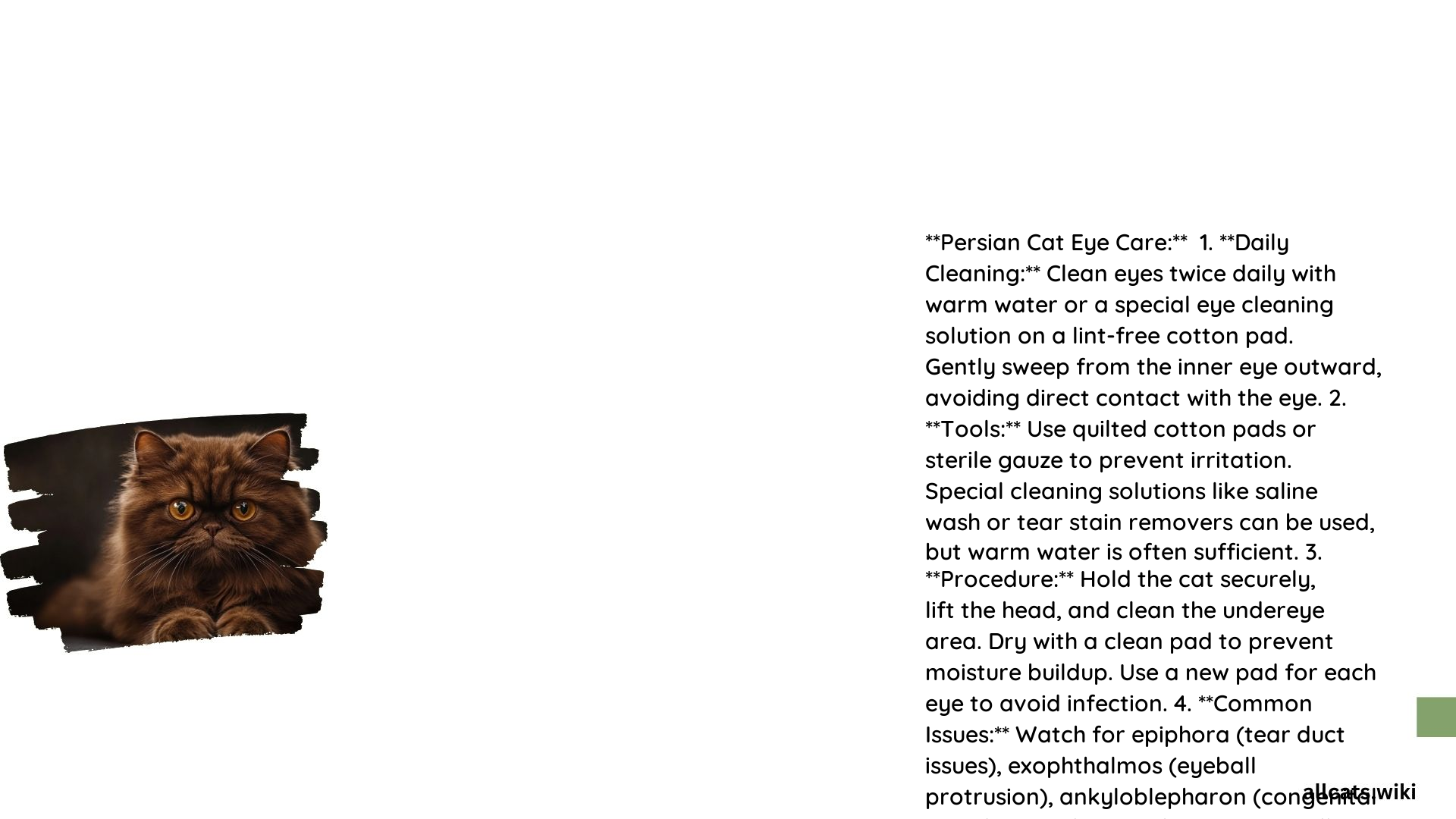Comprehensive Guide to Persian Cat Eye Care
Persian cats are known for their beautiful, expressive eyes, but their unique facial features can also make them prone to various eye problems. As a responsible pet owner, it’s crucial to understand the common eye issues Persian cats face and how to properly care for their delicate eyes. This comprehensive guide will provide you with the necessary information to ensure your Persian cat’s eye health and well-being.
What Are the Common Eye Problems in Persian Cats?
Tear Staining
- Description: Tear staining occurs due to the accumulation of tears on the fur around the eyes, leading to reddish-brown stains. This is common in Persian cats because of their underdeveloped tear ducts.
- Management:
- Daily Cleaning: Use a soft cloth, warm water, or a special cat eye-cleaning liquid to gently wipe the tear-stained area. Start from the inner eye and move outward to avoid pushing dirt into the eye.
- Products: Specialized tear stain removers like Eye Envy Tear Stain Remover Products can be effective.
- Preventive Measures: Apply a small amount of cream under the eyes to prevent new tears from staining the fur. Follow up with a powder to set the cream and prevent further staining.
Conjunctivitis
- Description: Conjunctivitis is an inflammation of the conjunctiva, the membrane covering the white part of the eyes and the inside of the eyelids. It can be caused by infections, allergies, or irritants.
- Management:
- Veterinary Care: If you suspect conjunctivitis, it is crucial to seek veterinary care. The vet may prescribe antibiotic ointments or drops if the cause is bacterial.
- Preventive Measures: Regular cleaning of the eyes can help prevent infections. Ensure the cleaning tools are clean and not shared between eyes to avoid spreading potential infections.
Corneal Ulcers
- Description: Corneal ulcers are painful and can lead to partial vision loss. They are more common in Persian cats due to conditions like exophthalmos.
- Management:
- Veterinary Care: Immediate veterinary attention is necessary if you suspect a corneal ulcer. The vet may prescribe pain relief medication and antibiotics.
- Preventive Measures: Regular eye cleaning and inspection can help identify early signs of corneal ulcers. Keeping the eyes clean and dry reduces the risk of infections.
How to Properly Clean Persian Cat Eyes?
Daily eye cleaning is essential for maintaining the health and appearance of Persian cats. Here’s a step-by-step guide on the best practices:
- Prepare Tools: Use a soft cloth, warm water, and a special cat eye-cleaning liquid if needed. Ensure your hands are clean.
- Make Your Cat Calm: Find a quiet spot and pet your cat to help them relax.
- Wet the Cloth: Make the cloth slightly damp with warm water. Avoid using too much water.
- Clean the Eyes: Gently wipe the tear-stained area from the inner eye outward. Use a different part of the cloth for each eye to avoid spreading potential infections.
- Dry the Area: Use a clean, dry cotton pad or a soft towel to pat the area gently and remove any residual moisture.
- Reward Your Cat: Give treats to make the experience positive and rewarding.
Recommended Products
- Soft Cloths: Use lint-free cotton pads or special pads designed for eye cleaning.
- Eye-Cleaning Liquids: Products like Eye Envy Tear Stain Remover or PinkPawPal Eye and Facial Cleansing Solution can be effective.
- Powders: Apply a powder like Wink-Eye Powder after cleaning to prevent new staining.
Frequency of Cleaning
- Daily Cleaning: Clean your Persian cat’s eyes about once a day. If their eyes get very dirty, you may need to clean them more often.
Techniques for Comfort
- Gentle Handling: Be gentle and patient. Start with small steps if your cat is not used to the process.
- Proper Holding: Hold your cat’s head carefully, avoiding the neck to prevent choking.
- Positive Reinforcement: Reward your cat with treats and praise to make the experience enjoyable.
When to Seek Veterinary Care for Persian Cat Eye Issues?
Identifying signs of eye infections early is crucial for the health of your Persian cat. Here are the key symptoms and when to seek veterinary care:
Symptoms of Eye Infections
- Excessive Tearing: More than usual tearing, especially if it is accompanied by redness or discharge.
- Redness and Swelling: Redness, swelling, or inflammation around the eyes.
- Discharge: Yellow or green discharge, which is a sign of infection.
- Squinting or Avoiding Light: If your cat shows discomfort or avoids light, it could indicate an eye problem.
When to Seek Veterinary Care
- Immediate Attention: If you notice any of the above symptoms, especially yellow or green discharge, it is critical to seek immediate veterinary care. Delaying treatment can lead to severe complications like corneal ulcers or vision loss.
- Potential Consequences: Ignoring eye infections can lead to chronic conditions, vision loss, or even systemic infections if left untreated.
By understanding the common eye problems in Persian cats, following proper eye-cleaning techniques, and being vigilant about signs of eye infections, you can help ensure your beloved feline companion maintains healthy and vibrant eyes for years to come.
References
- How to clean the eyes of a Persian cat – Dutchkittycat
https://dutchkittycat.com/2021/05/24/how-to-clean-the-eyes-of-a-persian-cat/ - How to Clean Persian Cat Eyes – Groom House
https://www.petgroomhouse.com/how-to-clean-persian-cat-eyes/ - Persian Cat Care and Eye Cleaning – Pelaqita Persians
https://pelaqitapersians.com/persian-cat-care-and-eye-cleaning/

